Googie's Coffee Shop
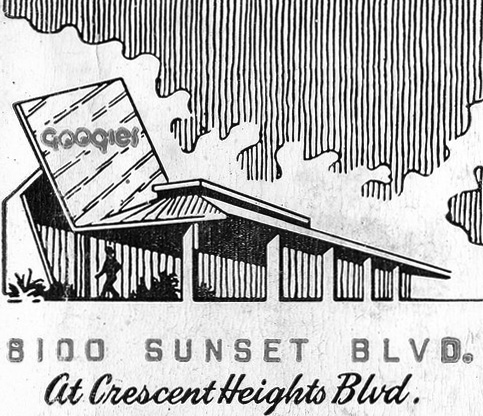 |
|
| (1950s)* - Matchbook cover image advertising Googie's Coffee Shop located at the SE corner of Sunset and Cresecent Heights boulevards. |
Historical Notes The origin of the name Googie dates to 1949, when architect John Lautner designed the West Hollywood coffee shop Googies, which had distinct architectural characteristics. The name "Googie" had been a family nickname of Lillian K. Burton, the wife of the original owner, Mortimer C. Burton. |
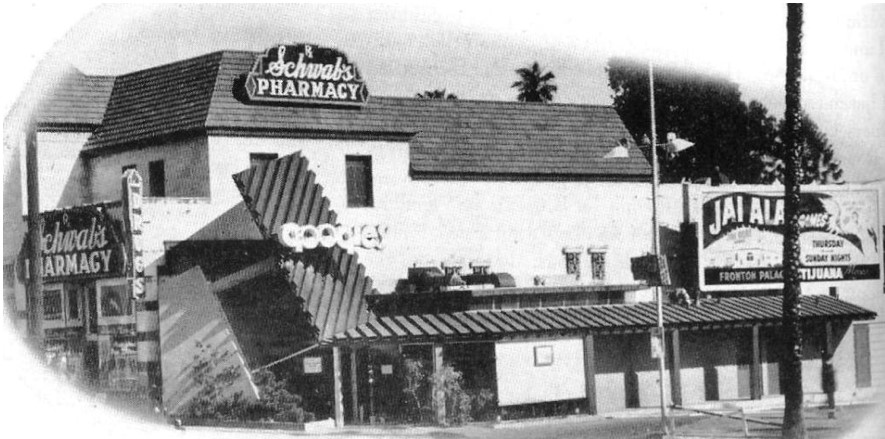 |
|
| (1950s)* - View showing Schwab’s Pharmacy and Googie’s Coffee Shop near the corner of Sunset Boulevard and Crescent Heights. Note the signboard on the right advertises the sport of Jai Alai at the Fronton Palace in Tijuana, Mexico. |
The Origins of Googie Architectrure Alan Hess, the author of Googie: Fifties Coffeeshop Architecture, traces Googie back to three Coffee Dan's restaurants designed by John Lautner in the early forties. "He selected the vaults and glass walls and trusses and angles of his buildings to fit the original, often unusual, concepts of space he favored," writes Hess. Lautner originated the style that would be refined and reinterpreted by many others. Unintentionally, he also gave the style a name when, in 1949, he designed Googie's Coffee Shop at the corner of Sunset Boulevard and Crescent Heights in Los Angeles. Professor Douglas Haskell of Yale was driving through Los Angeles when he and architectural photographer Julius Shulman came upon Googie's. "Stop the car!" Haskell yelled. "This is Googie architecture." While Haskell was dubious about the style, he made the name "Googie architecture" stick by using it in a 1952 article in House and Home magazine. |
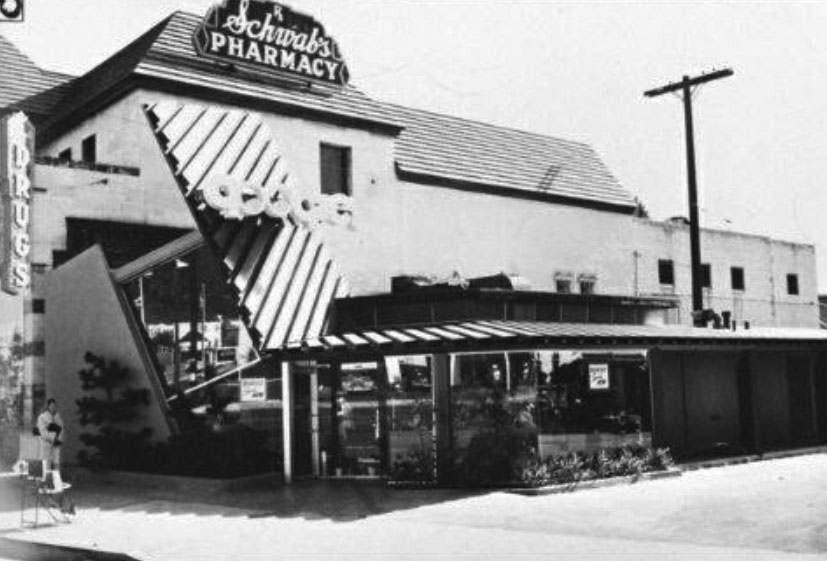 |
|
| (1952)* - Close-up view of Googie's Coffee shop and its neighbor Schwab’s Pharmacy located near the SE corner of Sunset and Crescent Heights. |
The Googie Look Although Googie buildings were often quite different from one another, Douglas Haskell noted that the style had certain rules: 1. It can look organic, but it must be abstract. "If it looks like a bird, it must be a geometric bird. It's better yet if the house had more than one theme: like an abstract mushroom surmounted by an abstract bird." 2. Ignore gravity altogether. "Whenever possible, the building must hang from the sky." 3. Multiple structural elements. Inclusion is the rule, rather than minimalism. New materials, including sheet glass, glass blocks, asbestos, plywood and plastic gave the architect a whole new palette to work with. Other innovations allowed steel and cement to be used in new ways. Suddenly, architects had more elbowroom for their dreams. A room made of plastic could look like a log cabin, a space ship, or almost anything. |
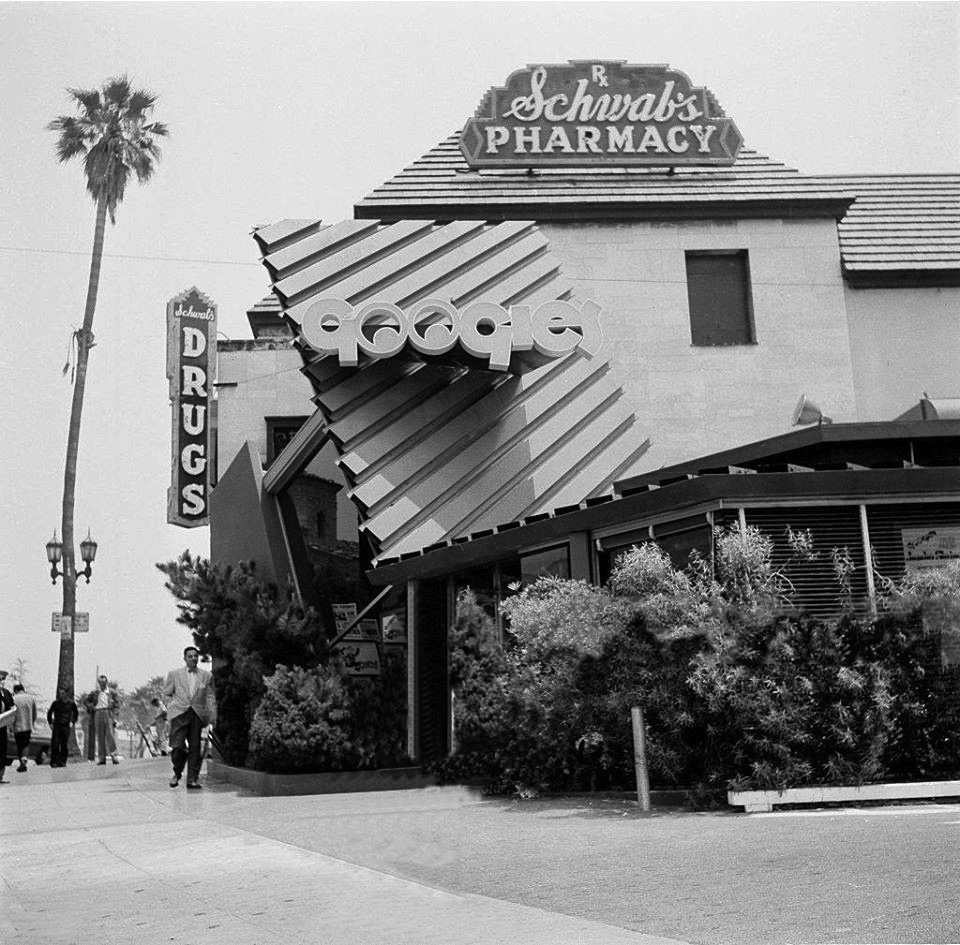 |
|
| (1954)* – A man in a light sport coat and bow tie walks by Schwab’s Pharmacy and Googies Coffee Shop. Photo courtesy of Bruce Ablin |
Historical Notes Googie’s Coffee Shop was located next door to celebrated Schwab’s drug store, on the corner of Sunset and Crescent Heights Boulevards. It was all the rage among young, up and coming stars in 1950s Hollywood who went to table hop, not necessarily to eat. |
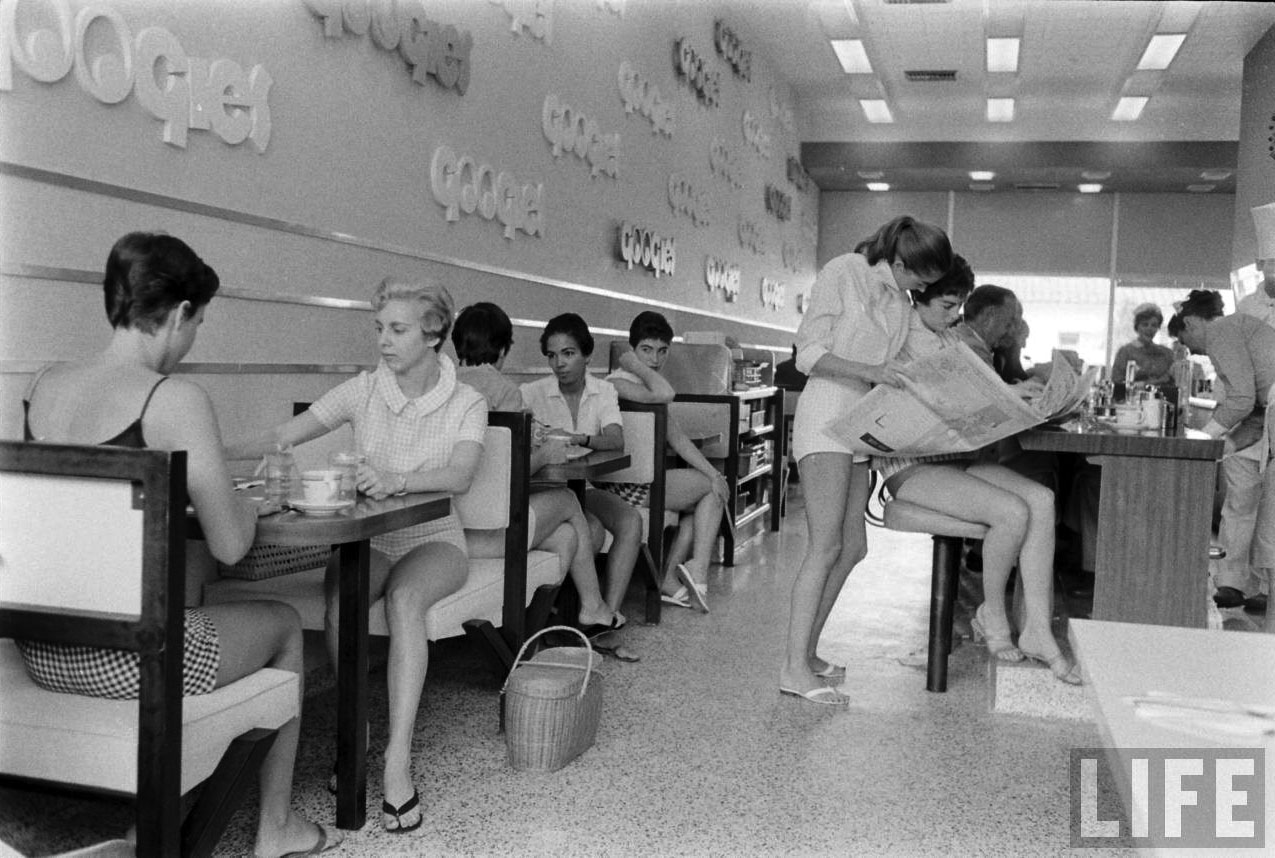 |
|
| (1950s)* - Interior view of Googie’s Coffee Shop whose quirky angles lent its name to a whole architectural style that became a distinctive addition to the Southern California landscape. Photo taken at the Googie’s located at 420 N Roxbury Drive, Beverly Hills, in the City National Bank building. Photo: Allan Grant, LIFE archives |
Historical Notes Googie captured the post-war high that made people feel that the future was now and they were living in it. As time passed, Googie came to reflect a very 1950s and ’60s view of what “the future” meant. |
 |
|
| (1950s)*- Shorts only at Googie's Coffee Shop. Photo taken at the Googie’s located at 420 N Roxbury Drive, Beverly Hills, in the City National Bank building. Photo: Allan Grant, LIFE archives |
Historical Notes Like most art forms that told a story or inspired with optimism, Googie went out of fashion in the mid-1960s. |
* * * * * |
Sunset and Crescent Heights
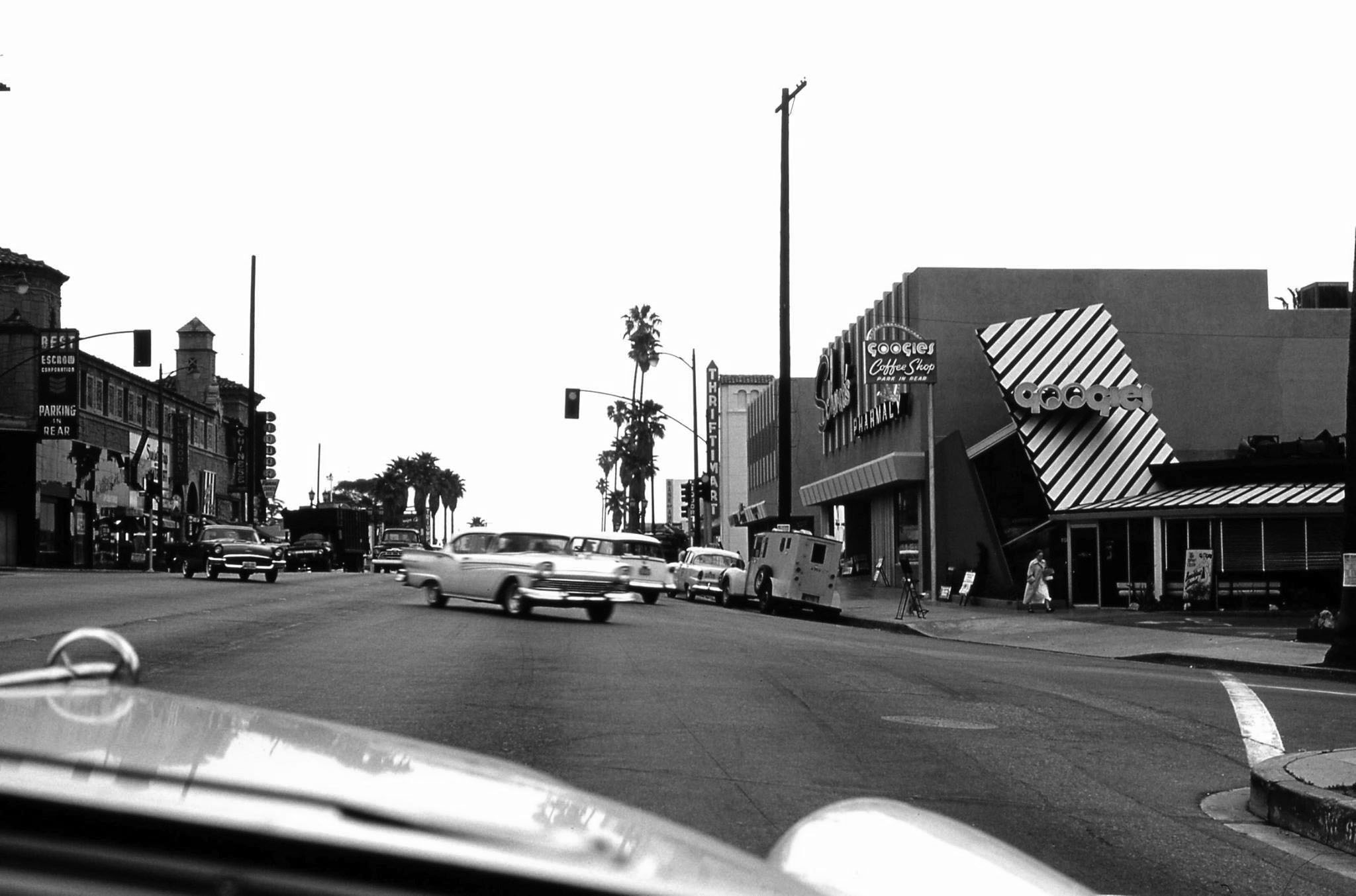 |
|
| (ca. 1957)* – View looking east on Sunset at Crescent Heights in West Hollywood as seen from the passenger seat of a long nose V8 bomb sight Buick. On the right is the original high style Googie's Coffee Shop and landmark Schwabs Drug Store. Photo courtesy of Kent Adamson and Richard Wojcik via Vintage Los Angeles |
Googie Architectrure In 1957, the intersection of Sunset and Crescent Heights boulevards was a lively Hollywood hotspot. The southeast corner featured Schwab's Pharmacy, a famed celebrity hangout, alongside Googie's Coffee Shop, John Lautner’s modernist landmark. Nearby, Crescent Heights Market and Pandora’s Box added to the area's eclectic charm. The mix of star-studded glamour, local commerce, and distinctive architecture—including possible remnants of the French Norman revival Sunset Medical Building—made this corner a quintessential snapshot of mid-century Tinseltown. |
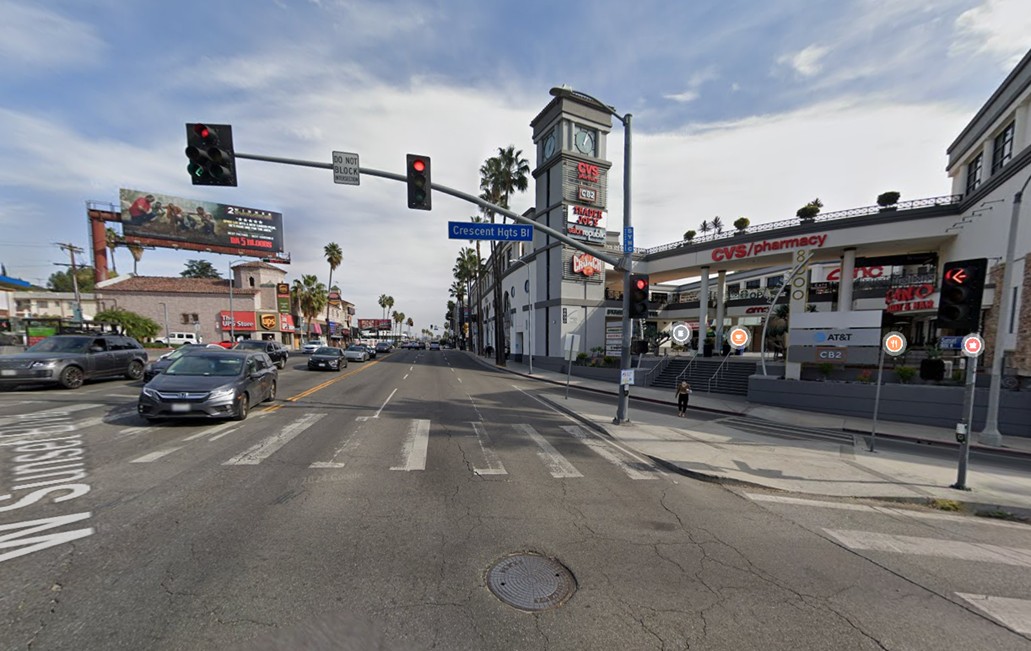 |
|
| (2021)* - Looking west on Sunset Boulevard at Crescent Heights Bouelvard with the 8000 Sunset Strip Shopping Center seenn on the southeast corner. |
Historical Notes The shopping center located at the southeast corner of Sunset Boulevard and Crescent Heights Boulevard is called 8000 Sunset Strip Shopping Center. It is a prominent retail and office complex in the West Hollywood area, featuring anchor tenants such as Trader Joe's, CVS, CB2, and Landmark Theatres. |
Then and Now
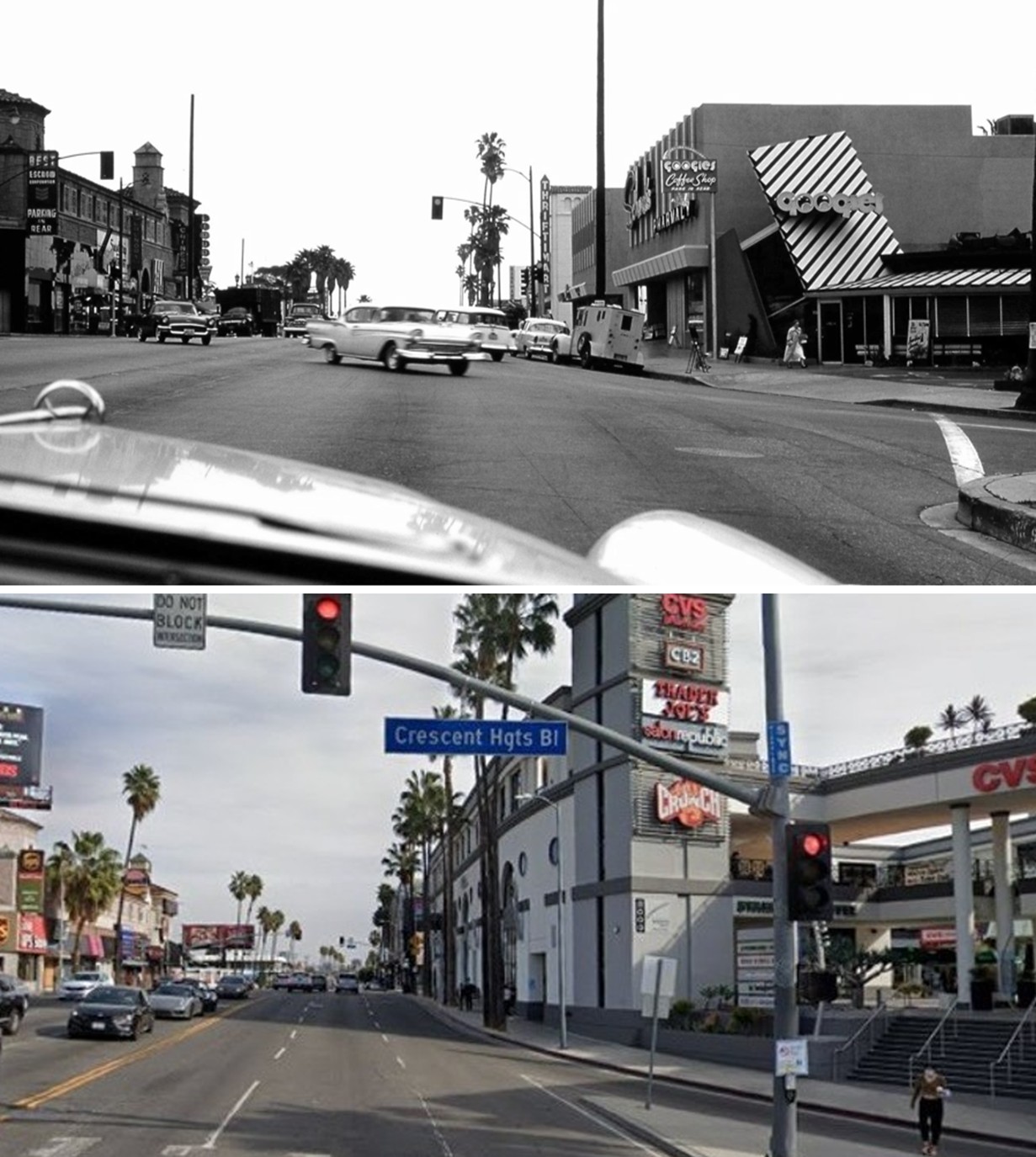 |
|
| (1957 vs 2021)* – A ‘Then and Now’ comparison looking east on Sunset Boulevard at Crescent Heights Boulevard. The southeast corner, once home to the iconic Googie's Coffee Shop and landmark Schwab’s Drug Store, is now occupied by the 8000 Sunset Strip Shopping Center. Photo comparison by Jack Feldman. |
* * * * * |
|
Other Sections of Interest |
|
Water and Power in Early LA |
|
Newest Additions |
New Search Index |

A new SEARCH INDEX has been added to help navigate through the thousands of topics and images found in our collection. Try it out for a test run.
Click HERE for Search Index |
* * * * * |
< Back
Menu
- Home
- Mission
- Museum
- Major Efforts
- Recent Newsletters
- Historical Op Ed Pieces
- Board Officers and Directors
- Mulholland/McCarthy Service Awards
- Positions on Owens Valley and the City of Los Angeles Issues
- Legislative Positions on
Water Issues
- Legislative Positions on
Energy Issues
- Membership
- Contact Us
- Search Index
© Copyright Water and Power Associates
Layout by Rocket Website Templates